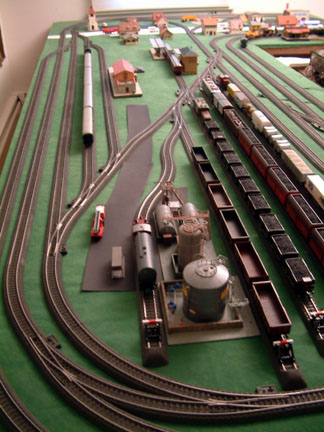 In the first half of the 20th century powered rail car trains were increasingly developed with drive gear that was an alternative to the steam propulsion that had predominated up till then. Initially electric propulsion made the greatest progress in this area. Diesel motors for railroading did not reach a suitable level until the 1920s to the 1930s. A total of 6 sets of the class E.T.501-506 were built and placed into regular service by the KPIEV as early as 1914. It turned out to be a thoroughly reliable powered rail car design. These powered rail cars were initially used for the routes in Silesia with their many grades. All 6 sets were designated as the class ET 87 on the German State Railroad. Three of these powered rail car trains remained in Bavaria after and were used there in Nomberg commuter service until 1959. The advantage of electric propulsion such as trouble-free service, low operating costs, and the lack of exhaust emissions were also an important factor for these models. The maximum speed of 70 km/h or 44 mph was considerably higher than the values that were reached with many other commuter trains. |
 With the electrification of the Gotthard route around 1920, the SBB developed new, heavy, articulated locomotives for this steep, winding rail line. The legendary name for these locomotives, "Crocodile", came from their long, flat ends. The final development of these machines was the Ce 6/8111, placed into service in 1926. These locomotives were painted brown, had 4 motors producing 1,810 kw of power through a jackshaft and drive rod system and had a maximum speed of 65 km/h (41 m.p.h.). In 1953 the maximum speed was raised to 75 km/h (47 m.p.h.) after the motors were rebuilt, and the "Crocodife's" designation was changed to Be 6/81". These locomotives had already been painted in the newer SBB green paint scheme prior to this time. |
 The V 60 is now employed by privately owned railroad in addition to various foreign railroads. Even the search for alternative locomotive fuels has been applied to the V 60. A natural gas version of this locomotive is being tested as the class 760. |

|
 |
 |

|
Connoisseurs have regarded the S
3/6 as
one of the most successful and beautiful locomotives in the world. The
unusual tapered cab, the coneshaped smokebox door and the immense
cylinder
block were characteristic features of this popular class. Its efficient
coal consumption and good running qualities proved its use in regular
operation.
The two inboard high pressure cylinders and the two outboard low
pressure
cylinders were coupled to the center driving wheels, A very high level
of thermodynamic efficiency was achieved with this four cylinder
propulsion
system.
The German State Railroad Company
acquired
these locomotives and designated them the class 18.4. Nineteen units
even
made their way to France and Belgium. The last locomotives of this
successful
class were retired in 1960. S 3/6 3673 has been in operation since 1996
at the Bavarian Railroad Museum in Nbrdlingen, Germany. |
| The Prussian P 8 designed by Robert Garbe was such a satisfactory locomotive in terms of its output and was such a favorite with engine crews that by 1928 approximately 3800 units were purchased by domestic and foreign railroads. Upon being transferred to the German State Railroad, this Prussian locomotive was classified as 3810-40. The P 8 was built in different variations right from the start and underwent a series of rebuidlings and changes during the course of its long life. The most noticeab a changes made by the German Federal Railroad were the flat smoke box door, new Witte smoke deflectors and four-axle tub tenders from the already retired class 42 and 52 locomotives. The last of these locomotives, now designated as class 038, were retired by the DB at the start of the 1970's. After both world wars many of these locomotives were in use on numerous foreign railroads. |

|
 |
 |
 |
 |
 |
 |
  |
At the beginning of
the 1930's the German State Railroad Company (DRG) built the so-called
"small locomotives" - lightweight, easy to operate, efficient
switch engines - to rationalize freight traffic. Most of of the units
were purchased as "Kof" - in German the "K" stands for small
locomotive, "o" for oil or diesel motor and 'f' for fluid transmission.
These locomotives varied in power according to the version produced and
proved themselves so well that additional units were purchased after
World War 11. The engineer's cab represents one of the most striking differences among the various versions of this locomotive, and it was built in an open or enclosed design, depending on the version of the locomotive. In addition to the German Federal Railroad, the Kof II was and is widely used by private firms. These locomotives are often painted in the colors of the respective companies. |
 |
 |
The Akron - Dorcherster RR

June 11, 2004
Back